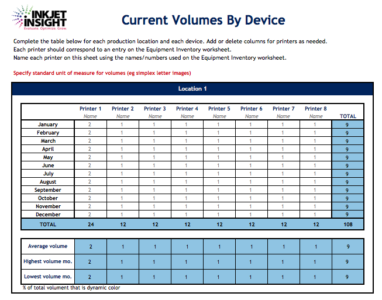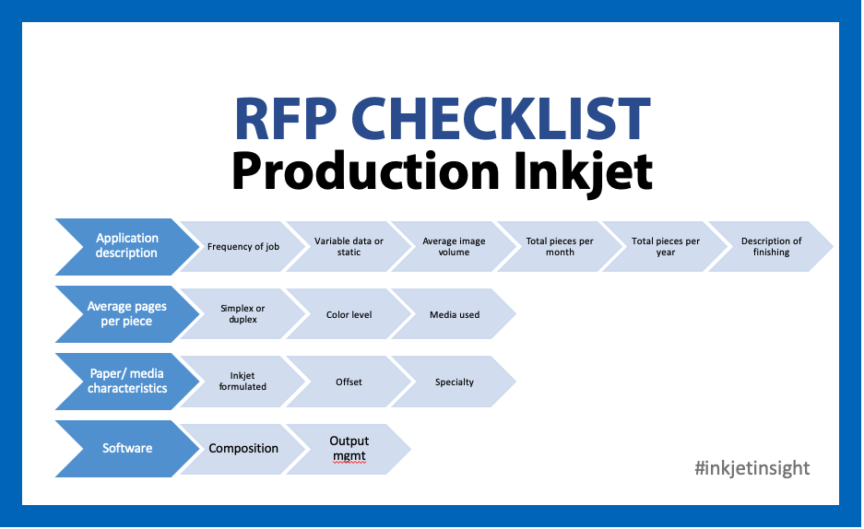Before you can effectively research your production inkjet options, you need to consider the features that are most important. That, of course, is dependent on the volumes you need to support, the types of applications those volumes represent and whether those volumes are existing business that needs to be transitioned or new business for your organization. It can be challenging enough for you to understand those factors internally, but you also have to be able to clearly communicate your requirements to the hardware, software and services partners you will be evaluating.
Potential suppliers will use these requirements to help you to determine what volumes can be successfully migrated, the logical order and the cost effectiveness of migration, as well as a likely timeline for completion. They must be detailed enough to enable your potential suppliers to determine the best solution to propose and the best strategy for getting you up and running as quickly as possible.
Below are some of the key areas to document, tools to help you communicate them, and some of the reasons why it is worth spending the time to gather this information. Spoiler alert – it’s a lot of information.
Your Current Production Environment
It is imperative that you document your current environment. Vendors will want an overall inventory of your production operation including software and hardware and descriptive information on how it is primarily used.
For each type of printing equipment
- What is it?
- Where is it?
- How many are there?
- How old are they?
- Are they leased or owned?
- If leased, when does the lease terminate?
- What is the capacity/utilization on each device (peak/off peak if applicable)?
- Reference any finishing or special capabilities that are in-line with the device.
- What types of applications are produced on the device (primarily)?
Provide the same type of information for any near-line or offline finishing equipment and inserting and/or mailing equipment.
Details of Historical Jobs and Volumes
Unless you are already experienced with inkjet production, we recommend that you provide details on applications and volumes and let vendors provide recommendations on a plan for migrating existing volumes to inkjet.
You’re going to be tempted to take shortcuts here. Don’t. This is the information you need to find out how profitable inkjet can be for you, and how fast you can achieve break-even volumes on an inkjet platform. It is necessary to look at overall volume and then slice and dice those volumes to determine if and how jobs can be grouped together in production.
Provide an overview of jobs by type. This information will differ for transaction print and other segments with primarily repeat/programmatic jobs versus those with varying volumes of direct mail, commercial print or books on demand. In the case of repeat business, it is easier to be specific about jobs and timing whereas with less programmatic business, it may only be possible to provide information on overall job or application types and a historical view of timing and volumes. Try to provide as much of the following information as possible:
- Job/Application description
- Frequency of job
- Average image volume of job
- Total pieces per month
- Total pieces per year
- Finished size of page/piece (e.g. 8.5×11, 11×17, A4)
- Average pages per piece or envelope
- Simplex or duplex
- Mono, highlight color, full color
- Uses pre-printed stock or plain paper (define paper)
- Paper stock characteristics*
- Describe any perforation
- Description of other finishing (die cut, gluing, binding, etc.)
- Variable data or static
- Software used for composition, pre and post processing
* with respect to paper characteristics, consider the underlying paper type (basis weight, finish, etc) and not just a list of preprinted stocks supplied by or for customers.
It is useful to look at this information for more than one year if possible. This avoids counting one-time volumes and gives a sense of seasonality and client tenure.
The Vision Thing
An investment in production inkjet is typically not about doing exactly what you do now. At a minimum there is a goal of doing things more efficiently. Sometimes there is a change from pre-printed stock to plain paper or from sheet fed to roll fed production. Perhaps you are changing your business model. Some companies have acquired inkjet on a “go forward” basis without using existing volumes to justify the purchase. If there is a major new client to justify the expense this can make sense – but you still will want to document what you want the “go forward” model to look like.
In any case, documenting your existing business is not enough. You need to think about what you want to do differently with inkjet, and what different things you may want to do. Make sure that potential vendors understand key considerations such as:
- Manual processes to be automated
- Processes to be improved or enhanced (postal automation, disaster recovery, finishing)
- Desired workflow changes
- The percent of inkjet volume you anticipate driving from new business versus existing business
- New business areas or application types to pursue
Consider doing a market analysis to look at new applications within your existing vertical markets that can be enabled by inkjet as well as new verticals that have similar characteristics. This process may help you to expand your description of “new business.”
Attached are documents to help you gather information in these key areas. It is painstaking and time consuming but you will not be able to efficiently migrate applications to inkjet without this information. Many companies are in such a rush to move forward with the evaluation process that they don’t gather this information until the implementation phase. At that point it’s too late to realize that there are features that would have allowed you transition more business, operate more efficiently or justify the leap to a higher grade device. You will need this information, so better to put it together before you buy then find out you’ve been sold.
Author’s Note: later in the buying process, you will be able to draw on a subset of this data to conduct testing with suppliers and develop acceptance test plans, but for now we are really focused on the shopping experience.
RFP Checklist – Business Requirements Tools
Print Equipment Inventory Worksheet 
Current Volumes by Type Worksheet
Current Volumes by Device Worksheet
Please provide your suggestions and other feedback on RFP Checklists.

